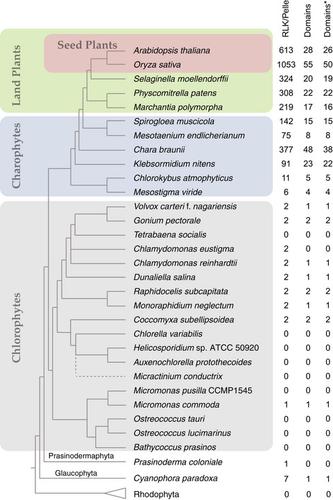Our official English website, www.x-mol.net, welcomes your feedback! (Note: you will need to create a separate account there.)
Flourishing in water: the early evolution and diversification of plant receptor‐like kinases
The Plant Journal ( IF 7.2 ) Pub Date : 2021-01-10 , DOI: 10.1111/tpj.15157 Zhen Gong 1 , Guan-Zhu Han 1
The Plant Journal ( IF 7.2 ) Pub Date : 2021-01-10 , DOI: 10.1111/tpj.15157 Zhen Gong 1 , Guan-Zhu Han 1
Affiliation

|
Receptor‐like kinases (RLKs) play significant roles in mediating innate immunity and development of plants. The evolution of plant RLKs has been characterized by extensive variation in copy numbers and domain configurations. However, much remains unknown about the origin, evolution, and early diversification of plant RLKs. Here, we perform phylogenomic analyses of RLKs across plants (Archaeplastida), including embryophytes, charophytes, chlorophytes, prasinodermophytes, glaucophytes, and rhodophytes. We identify the presence of RLKs in all the streptophytes (land plants and charophytes), nine out of 18 chlorophytes, one prasinodermophyte, and one glaucophyte, but not in rhodophytes. Interestingly, the copy number of RLKs increased drastically in streptophytes after the split of the clade of Mesostigmatophyceae and Chlorokybophyceae and other streptophytes. Moreover, phylogenetic analyses suggest RLKs from charophytes form diverse distinct clusters, and are dispersed along the diversity of land plant RLKs, indicating that RLKs have extensively diversified in charophytes and charophyte RLKs seeded the major diversity of land plant RLKs. We identify at least 81 and 76 different kinase‐associated domains for charophyte and land plant RLKs, 23 of which are shared, suggesting that RLKs might have evolved in a modular fashion through frequent domain gains or losses. We also detect signatures of positive selection for many charophyte RLK groups, indicating potential functions in host–microbe interaction. Taken together, our findings provide significant insights into the early evolution and diversification of plant RLKs and the ancient evolution of plant–microbe symbiosis.
中文翻译:

在水中蓬勃发展:植物受体样激酶的早期进化和多样化
受体样激酶 (RLK) 在介导先天免疫和植物发育方面发挥重要作用。植物 RLK 进化的特点是拷贝数和结构域配置的广泛变化。然而,关于植物 RLK 的起源、进化和早期多样化还有很多未知。在这里,我们对植物(古生菌)中的 RLK 进行系统发育分析,包括胚植物、轮藻、叶绿植物、草皮植物、绿藻和红藻。我们在所有链霉菌(陆地植物和轮藻)、18 种叶绿植物中的 9 种、一种草皮植物和一种绿藻中鉴定出 RLK,但在红藻中没有。有趣的是,中柱藻科和叶绿藻科及其他链霉菌分裂后,链霉菌中RLKs的拷贝数急剧增加。此外,系统发育分析表明来自轮藻的 RLK 形成不同的不同簇,并沿着陆地植物 RLK 的多样性分散,表明 RLK 在轮藻中具有广泛的多样性,并且轮藻 RLK 播种了陆地植物 RLK 的主要多样性。我们为轮藻和陆地植物 RLK 确定了至少 81 和 76 个不同的激酶相关域,其中 23 个是共享的,这表明 RLK 可能通过频繁的域获得或损失以模块化方式进化。我们还检测到许多轮藻 RLK 组的正选择特征,表明宿主-微生物相互作用中的潜在功能。综合起来,
更新日期:2021-01-10
中文翻译:

在水中蓬勃发展:植物受体样激酶的早期进化和多样化
受体样激酶 (RLK) 在介导先天免疫和植物发育方面发挥重要作用。植物 RLK 进化的特点是拷贝数和结构域配置的广泛变化。然而,关于植物 RLK 的起源、进化和早期多样化还有很多未知。在这里,我们对植物(古生菌)中的 RLK 进行系统发育分析,包括胚植物、轮藻、叶绿植物、草皮植物、绿藻和红藻。我们在所有链霉菌(陆地植物和轮藻)、18 种叶绿植物中的 9 种、一种草皮植物和一种绿藻中鉴定出 RLK,但在红藻中没有。有趣的是,中柱藻科和叶绿藻科及其他链霉菌分裂后,链霉菌中RLKs的拷贝数急剧增加。此外,系统发育分析表明来自轮藻的 RLK 形成不同的不同簇,并沿着陆地植物 RLK 的多样性分散,表明 RLK 在轮藻中具有广泛的多样性,并且轮藻 RLK 播种了陆地植物 RLK 的主要多样性。我们为轮藻和陆地植物 RLK 确定了至少 81 和 76 个不同的激酶相关域,其中 23 个是共享的,这表明 RLK 可能通过频繁的域获得或损失以模块化方式进化。我们还检测到许多轮藻 RLK 组的正选择特征,表明宿主-微生物相互作用中的潜在功能。综合起来,



























 京公网安备 11010802027423号
京公网安备 11010802027423号